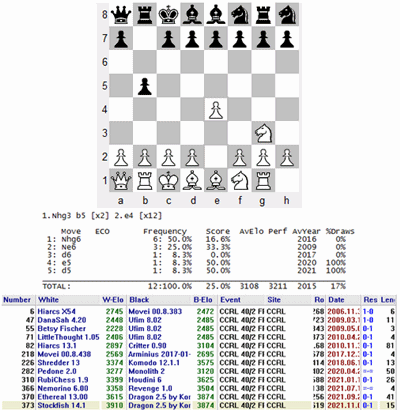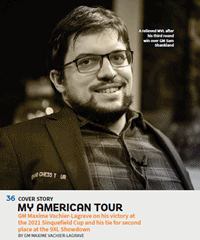This month I started a new eight-game (four different start positions) event and decided to take another look at the CCRL data. One of the games, SP777 QRKBBNRN, is pictured below.

SP777 QRKBBNRN
For the game where I had white, I chose 1.Nhg3 as the first move, and the game continued...
1.Nhg3 [x89] b5 [x2] 2.e4 [x12]
...reaching the position in the diagram. The numbers in brackets ('[]') are the number of games in the CCRL file for SP777, out of 378 games total. After Black's first move, only two CCRL games remained, but the number increased after White's second move, thanks to a simple transposition of White's first and second moves.
The first block of text in the image, statistics calculated by SCID, shows Black's moves after 2.e4. The numbers are terrible for White -- in the 12 games, White scored only 25%. When I first saw the stats, I told myself, 'This line is unplayable!', but couldn't see any other reason why it shouldn't be played. It's the most logical move in the position.
The second block of text shows some basic info about the 12 games, listed in chronological order. The last two columns are the most interesting. The WLD scores total +2-8=2 (25%), but the last column shows the 'Length' (number of moves) for each game. Of the 12 games, only four lasted longer than 15 moves.
The first game, Hiarcs - Movei (played 2006), ended '1-0' after Black's 6th move, when the opponent's are still developing their forces. The last game, Stockfish - Dragon (played this year), ended after White's 15th move with the comment 'Black wins by adjudication', although the position is at best unclear.
My conclusion? The CCRL statistics are completely misleading and can't be relied on. My own SP777 game hasn't yet reached the 10th move, so I can't say anything else, because it's still in progress.
***
Later: Re 'Of the 12 games, only four lasted longer than 15 moves', after I wrote the post, I realized I had made a serious error. SCID doesn't know anything about chess960. When it encounters an illegal move, it stops processing the game. For chess960 games, most castling moves look like errors, so SCID stops. Thus the low move counts.
For the first three games in my list, the real plycounts were 99, 511, and 122, where the number of 'moves' in the game (more accurately called 'move pairs', i.e. a move for White plus a move for Black) would be half that. This reminded me of an equally serious error I made on my main blog in the first few months of chess960 blogging, when I miscalculated CCRL statistics:-
- Theoretical Advantage in Chess960 Start Positions (December 2008)
- A Followup, an Error, and an Insight (ditto)
My conclusion now? (1) I'm the one that's unreliable, not the CCRL; (2) I shouldn't blog on Christmas day, the date of this post; (3) I should be careful when I find a simple answer to a complicated question.
Re the original observation, 'The numbers are terrible for White -- in the 12 games, White scored only 25%', I'll have to look at it again. The game that provoked the analysis has reached the 17th move, so it is still too early to comment.
 I knew this was going to happen. It was just a question of time.
Not everyone is comfortable with Roman numerals, and of those who are, not everyone knows what 'L' stands for.
I knew this was going to happen. It was just a question of time.
Not everyone is comfortable with Roman numerals, and of those who are, not everyone knows what 'L' stands for.
